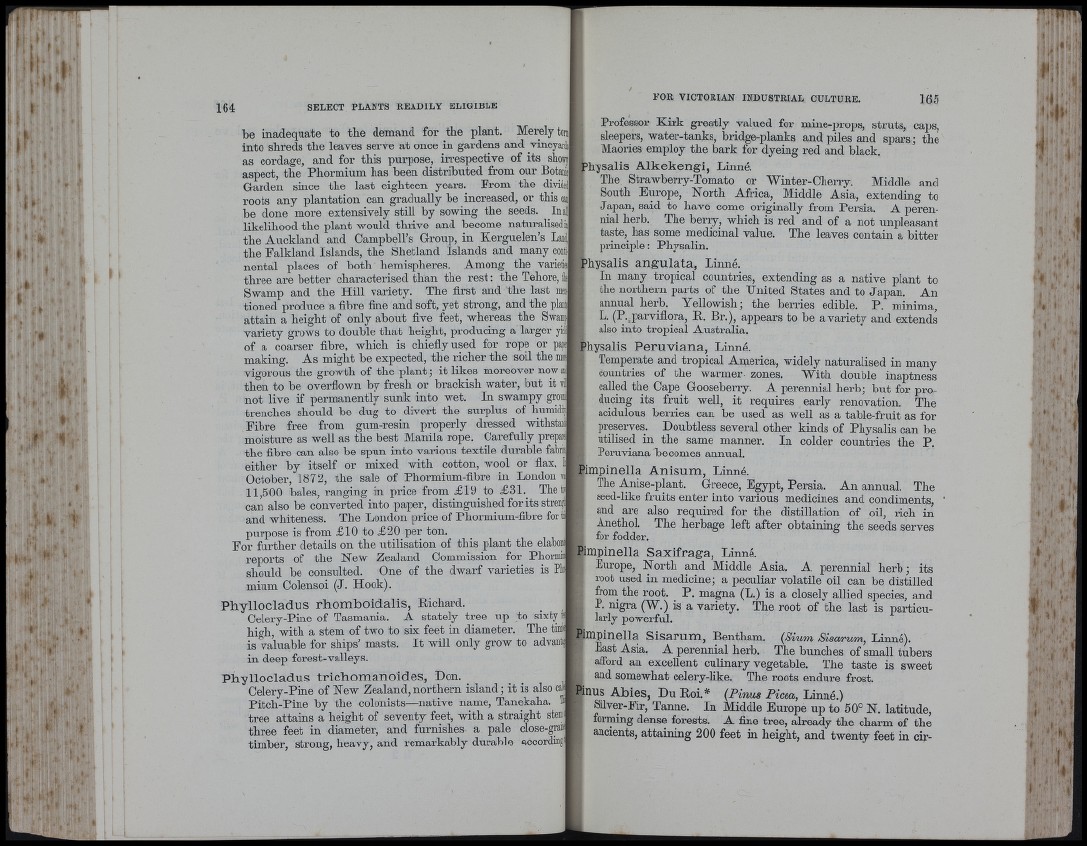
: ii f
'W H * ‘
J |n
I
Il ■
1 6 4 , SELECT PLANTS READILY ELIGIBLE
be inadequate to tbe demand for the plant. Merely ton
into shreds the leaves serve at once in gardens and vineyari
as cordage, and for this purpose, irrespective of its shovj
aspect, the Phormium has been distributed from onr Botani
Garden since the last eighteen years. From the dividej
roots any plantation can gradually be increased, or this cat
be done more extensively still by sowing the seeds. In a
likelihood the plant would thrive and become naturalised ii
the Auckland and Campbell’s Group, in Kerguelen’s Lani
the Falkland Islands, the Shetland Islands and many conti
nental places of both hemispheres. Among the varietis
three are better characterised than the rest : the Tehore, 4
Swamp and the Hill variety. The first and the last meii.
tioned produce a fibre fine and soft, yet strong, and the plaii
attain a height of only about five feet, whereas the Swam
variety grows to double th a t height, producing a larger yieii
of a coarser fibre, which is chiefly used for rope or papt
making. As might be expected, tbe richer tbe soil the mos
vigorous the growth of the plant; it likes moreover nowai:
then to be overflown by fresh or brackish water, bnt it mi
not live if permanently sunk into wet. In swampy groiit:
trenches should be dug to divert the surplus of humiditi
Fibre free from gum-resin properly dressed withstaini
moisture as well as the best Manila rope. Carefully prepare
the fibre can also be spun into various textile durable fakk
either by itself or mixed with cotton, wool or flax, 1
October, 1872, the sale of Pborminm-fibre in London m
11,500 bales, ranging in price from £19 to £31. The to
can also be converted into paper, distinguished for its strenf
and whiteness. Tbe London price of Phormium-fibre for to
purpose is from £ 1 0 to £ 2 0 per ton.
For further details on the utilisation of tbis plant the élabore:
reports of the New Zealand Commission for Phornik
should be consulted. One of the dwarf varieties is Pb
mium Colensoi (J. Hook).
PByllocladus rhomboidalis, Bichard.
Celery-Pine of Tasmania. A stately tree up to sixty ft
high, with a stem of two to six feet in diameter. The tiffik
is valuable for ships’ masts. I t will only grow to advanto
in deep forest-valleys.
Phyllocladus trichomanoîdes, Don.
Celery-Pine of New Zealand, northern island; it is also calir
Pitch-Pine by the colonists—native name, Tanekaha. f
tree attains a height of seventy feet, with a straight stem:
three feet in diameter, and furnislies a pale close-grato
timber, strong, heavy, and remarkably durable a c c o r d k g :
Professor Kirk greatly valued for mine-props, struts, caps,
sleepers, water-tanks, bridge-planks and piles and spars; the
Maories employ the bark for dyeing red and black.
Physalis Alkekengi, Linné.
The Strawberry-Tomato or Winter-Cherry. Middle and
South Europe, North Africa, Middle Asia, extending to
Japan, said to have come originally from Persia. A perennial
herb. The berry, which is red and of a not unpleasant
taste,^ has some medicinal value. The leaves contain a bitter
principle : Physalin.
Physalis angulata, Linné.
In many tropical countries, extending as a native plant to
the northern parts of the United States and to Japan. An
annual herb. Yellowish; the berries edible. P. minima,
L. (P.^parviflora, E. Br.), appears to be a variety and extends
also into tropical Australia.
Physalis Peruviana, Linné.
Temperate and tropical America, widely naturalised in many
countries of the warmer, zones. With double inaptness
called the Cape Gooseberry. A perennial herb; but for producing
its fruit well, it requires early renovation. The
acidulous berries can be used as well as a table-fruit as for
preserves. Doubtless several other kinds of Physalis can be
utilised in the same manner. In colder countries the P.
Peruviana becomes annual.
Pimpinella Anisum, Linné.
The Anise-plant. Greece, Egypt, Persia. An annual. The
seed-like fruits enter into various medicines and condiments,
and are also required for the distillation of oil, rich in
Anethol. The herbage left after obtaining the seeds serves
for fodder.
Pimpinella Saxifraga, Linné.
Europe, North and Middle Asia. A. perennial herb; its
root used in medicine; a peculiar volatile oil can be distilled
from, the root. P . magna (L.) is a closely allied species, and
P. nigra (W.) is a variety. The root of the last is particularly
powerful.
Pimpinella Sisarum, Bentham. (Sium Sisarum, Linné).
East Asia. A perennial herb. The bunches of small tubers
afford an excellent culinary vegetable. The taste is sweet
and somewhat celery-like. The roots endure frost.
Pinus Abies, Du Boi.* (Pinus Picea, Linné.)
Süver-Eir, Tanne. In Middle Europe up to 50° N. latitude,
fo r i^ g dense forests. A fine tree, already the charm of the
ancients, attaining 200 feet in height, and twenty feet in cir